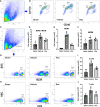Janus Kinase Inhibition Ameliorates Ischemic Stroke Injury and Neuroinflammation Through Reducing NLRP3 Inflammasome Activation via JAK2/STAT3 Pathway Inhibition
- PMID: 34367186
- PMCID: PMC8339584
- DOI: 10.3389/fimmu.2021.714943
Janus Kinase Inhibition Ameliorates Ischemic Stroke Injury and Neuroinflammation Through Reducing NLRP3 Inflammasome Activation via JAK2/STAT3 Pathway Inhibition
Abstract
Background: Inflammatory responses play a multiphase role in the pathogenesis of cerebral ischemic stroke (IS). Ruxolitinib (Rux), a selective oral JAK 1/2 inhibitor, reduces inflammatory responses via the JAK2/STAT3 pathway. Based on its anti-inflammatory and immunosuppressive effects, we hypothesized that it may have a protective effect against stroke. The aim of this study was to investigate whether inhibition of JAK2 has a neuroprotective effect on ischemic stroke and to explore the potential molecular mechanisms.
Methods: Rux, MCC950 or vehicle was applied to middle cerebral artery occlusion (MCAO) mice in vivo and an oxygen-glucose deprivation/reoxygenation (OGD/R) model in vitro. After 3 days of reperfusion, neurological deficit scores, infarct volume and brain water content were assessed. Immunofluorescence staining and western blots were used to measure the expression of NLRP3 inflammasome components. The infiltrating cells were investigated by flow cytometry. Proinflammatory cytokines were assessed by RT-qPCR. The expression of the JAK2/STAT3 pathway was measured by western blots. Local STAT3 deficiency in brain tissue was established with a lentiviral vector carrying STAT3 shRNA, and chromatin immunoprecipitation (ChIP) assays were used to investigate the interplay between NLRP3 and STAT3 signaling.
Results: Rux treatment improved neurological scores, decreased the infarct size and ameliorated cerebral edema 3 days after stroke. In addition, immunofluorescence staining and western blots showed that Rux application inhibited the expression of proteins related to the NLRP3 inflammasome and phosphorylated STAT3 (P-STAT3) in neurons and microglia/macrophages. Furthermore, Rux administration inhibited the expression of proinflammatory cytokines, including TNF-α, IFN-γ, HMGB1, IL-1β, IL-2, and IL-6, suggesting that Rux may alleviate IS injury by inhibiting proinflammatory reactions via JAK2/STAT3 signaling pathway regulation. Infiltrating macrophages, B, T, cells were also reduced by Rux. Local STAT3 deficiency in brain tissue decreased histone H3 and H4 acetylation on the NLRP3 promoter and NLRP3 inflammasome component expression, indicating that the NLRP3 inflammasome may be directly regulated by STAT3 signaling. Rux application suppressed lipopolysaccharide (LPS)-induced NLRP3 inflammasome secretion and JAK2/STAT3 pathway activation in the OGD/R model in vitro.
Conclusion: JAK2 inhibition by Rux in MCAO mice decreased STAT3 phosphorylation, thus inhibiting the expression of downstream proinflammatory cytokines and the acetylation of histones H3 and H4 on the NLRP3 promoter, resulting in the downregulation of NLRP3 inflammasome expression.
Keywords: JAK2/STAT3; NLRP3 inflammasome; ischemic stroke; neuroinflammation; ruxolitinib.
Copyright © 2021 Zhu, Jian, Zhong, Ye, Zhang, Hu, Pu, Gu and Xiong.
Conflict of interest statement
The authors declare that the research was conducted in the absence of any commercial or financial relationships that could be construed as a potential conflict of interest.
Figures











Similar articles
-
Phenothiazine Inhibits Neuroinflammation and Inflammasome Activation Independent of Hypothermia After Ischemic Stroke.Mol Neurobiol. 2021 Dec;58(12):6136-6152. doi: 10.1007/s12035-021-02542-3. Epub 2021 Aug 29. Mol Neurobiol. 2021. PMID: 34455546
-
Atractylenolide III ameliorates cerebral ischemic injury and neuroinflammation associated with inhibiting JAK2/STAT3/Drp1-dependent mitochondrial fission in microglia.Phytomedicine. 2019 Jun;59:152922. doi: 10.1016/j.phymed.2019.152922. Epub 2019 Apr 6. Phytomedicine. 2019. PMID: 30981186
-
Upregulation of miR-216a exerts neuroprotective effects against ischemic injury through negatively regulating JAK2/STAT3-involved apoptosis and inflammatory pathways.J Neurosurg. 2019 Mar 1;130(3):977-988. doi: 10.3171/2017.5.JNS163165. Epub 2018 Mar 9. J Neurosurg. 2019. PMID: 29521586
-
Relevant mediators involved in and therapies targeting the inflammatory response induced by activation of the NLRP3 inflammasome in ischemic stroke.J Neuroinflammation. 2021 May 31;18(1):123. doi: 10.1186/s12974-021-02137-8. J Neuroinflammation. 2021. PMID: 34059091 Free PMC article. Review.
-
Neuroinflammation and COVID-19 Ischemic Stroke Recovery-Evolving Evidence for the Mediating Roles of the ACE2/Angiotensin-(1-7)/Mas Receptor Axis and NLRP3 Inflammasome.Int J Mol Sci. 2022 Mar 13;23(6):3085. doi: 10.3390/ijms23063085. Int J Mol Sci. 2022. PMID: 35328506 Free PMC article. Review.
Cited by
-
ATG5 Knockdown Attenuates Ischemia‒Reperfusion Injury by Reducing Excessive Autophagy-Induced Ferroptosis.Transl Stroke Res. 2024 Feb;15(1):153-164. doi: 10.1007/s12975-022-01118-0. Epub 2022 Dec 16. Transl Stroke Res. 2024. PMID: 36522583
-
Corosolic acid enhances oxidative stress-induced apoptosis and senescence in pancreatic cancer cells by inhibiting the JAK2/STAT3 pathway.Mol Biol Rep. 2024 Jan 22;51(1):176. doi: 10.1007/s11033-023-09105-w. Mol Biol Rep. 2024. PMID: 38252208
-
Isobavachalcone's Alleviation of Pyroptosis Contributes to Enhanced Apoptosis in Glioblastoma: Possible Involvement of NLRP3.Mol Neurobiol. 2022 Nov;59(11):6934-6955. doi: 10.1007/s12035-022-03010-2. Epub 2022 Sep 2. Mol Neurobiol. 2022. PMID: 36053436
-
Huanglian Jiedu decoction alleviates ischemia-induced cerebral injury in rats by mitigating NET formation and activiting GABAergic synapses.J Cell Mol Med. 2024 Aug;28(15):e18528. doi: 10.1111/jcmm.18528. J Cell Mol Med. 2024. PMID: 39099086 Free PMC article.
-
The JAK-STAT Signaling Pathway in Epilepsy.Curr Neuropharmacol. 2023;21(10):2049-2069. doi: 10.2174/1570159X21666221214170234. Curr Neuropharmacol. 2023. PMID: 36518035 Free PMC article. Review.
References
-
- Guekht A, Skoog I, Edmundson S, Zakharov V, Korczyn AD. Artemida Trial (a Randomized Trial of Efficacy, 12 Months International Double-Blind Actovegin): A Randomized Controlled Trial to Assess the Efficacy of Actovegin in Poststroke Cognitive Impairment. Stroke (2017) 48(5):1262–70. 10.1161/strokeaha.116.014321 - DOI - PMC - PubMed
Publication types
MeSH terms
Substances
LinkOut - more resources
Full Text Sources
Medical
Research Materials
Miscellaneous

